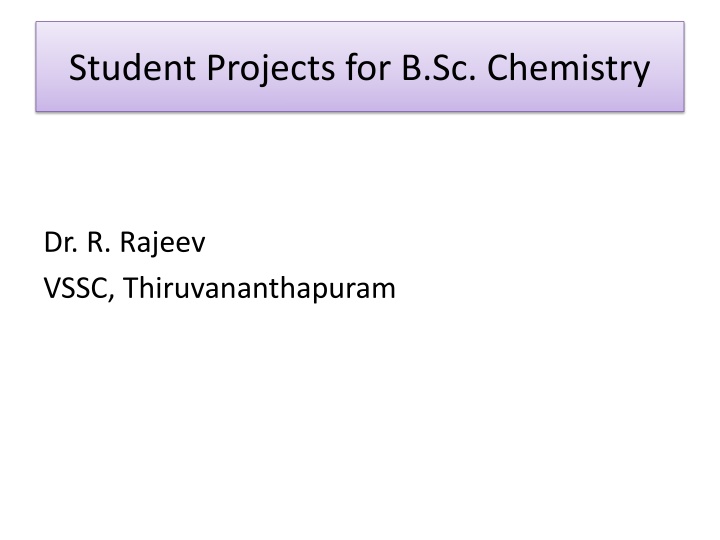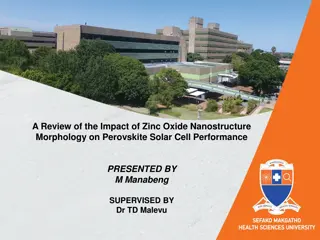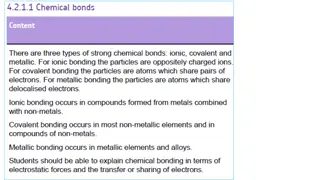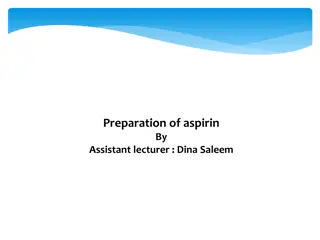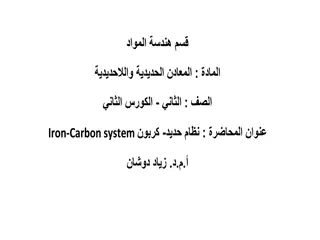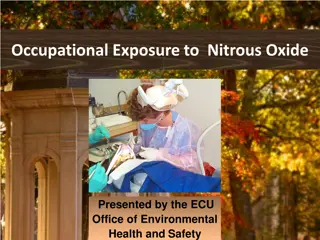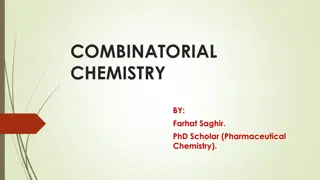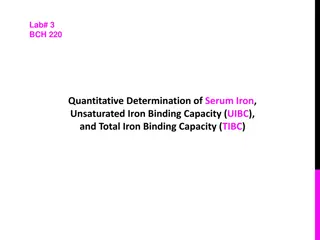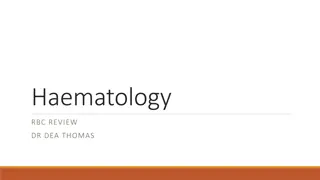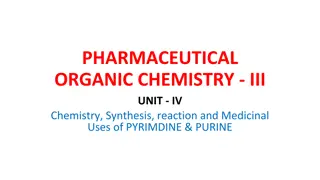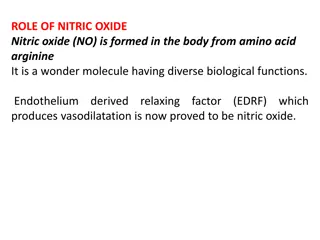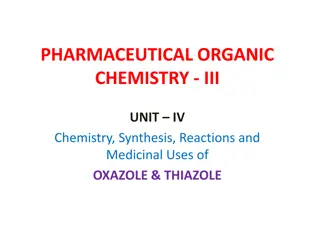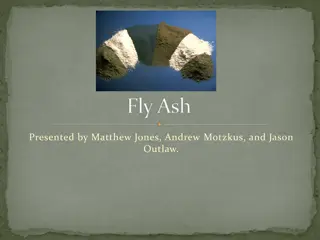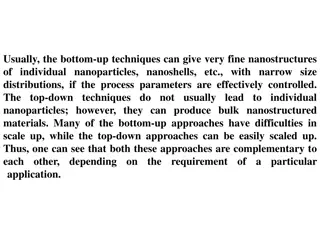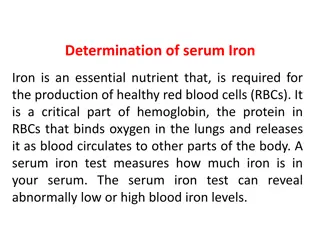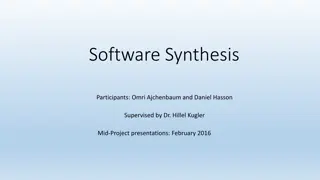Exploration of Synthesis Methods and Applications of Iron Oxide in Chemistry Projects
Delve into the world of iron oxide synthesis and applications in chemistry projects, covering topics such as the properties, precipitation techniques, and particle characteristics. Learn about the various phases of iron oxide and different synthesis methods, from precipitation to combustion techniques, providing a comprehensive guide for student projects in B.Sc. Chemistry.
Download Presentation

Please find below an Image/Link to download the presentation.
The content on the website is provided AS IS for your information and personal use only. It may not be sold, licensed, or shared on other websites without obtaining consent from the author.If you encounter any issues during the download, it is possible that the publisher has removed the file from their server.
You are allowed to download the files provided on this website for personal or commercial use, subject to the condition that they are used lawfully. All files are the property of their respective owners.
The content on the website is provided AS IS for your information and personal use only. It may not be sold, licensed, or shared on other websites without obtaining consent from the author.
E N D
Presentation Transcript
Student Projects for B.Sc. Chemistry Dr. R. Rajeev VSSC, Thiruvananthapuram
Project Feasibility Introduction Relevance Applications Literature survey Scope of work Experimental Procedure Materials Instrumentation for experiments and characterization Results & Discussion Conclusions Acknowledgements References
Where to find a topic / subject Inorganic Chemistry Synthesis of metal oxides Applications metallurgy, catalysts, fillers in composites, ceramics, pigments, paints Properties Inertness, catalytic activity, stability, purity, colour Thermal , electrical , magnetic and spectral properties Particle characteristics like size (macro, micro, nano), shape, surface area, porosity Properties varies with method of preparation, heat treatment, precursor
Iron oxide Oxides of Iron iron(II) oxide, w stite (FeO) iron(II,III) oxide, magnetite (Fe3O4) iron(III) oxide (Fe2O3) alpha phase, hematite ( -Fe2O3) beta phase, ( -Fe2O3) gamma phase, maghemite ( -Fe2O3) epsilon phase, ( -Fe2O3) Hydroxides iron(II) hydroxide (Fe(OH)2) iron(III) hydroxide (Fe(OH)3), (bernalite) Oxide/hydroxides goethite ( -FeOOH), akagan ite ( -FeOOH), lepidocrocite ( -FeOOH), feroxyhyte ( -FeOOH), ferrihydrite (Fe5HO8 4H2O approx.), or 5Fe2O3 9H2O, better recast as FeOOH 0.4H2O high-pressure FeOOH schwertmannite (ideally Fe8O8(OH)6(SO) nH2O or Fe3+16O16(OH,SO4)12-13 10-12H2O) green rust (FeIIIxFeIIy(OH)3x+2y-z(A-)z; where A-is Cl-or 0.5SO42-)
Synthesis Precipitation of from an aqueous solution of iron compound Precipitating agent,, ammonia, NaOH, KOH, amines Temperature- RT, Hydrothermal, autoclave, microwave Homogeneous precipitation- urea, hexamine Thermal decomposition of Iron compounds Iron salts inorganic / organic Nitrate, carbonate, sulphate, perchlorate / oxalate, citrate, tartrate Iron complexes- Atmosphere - oxidizing, reducing, inert
Synthesis of Nano Iron oxide particles Combustion technique Vapour deposition Sol-Gel method Template method Homogeneous precipitation Powdering- ball milling, Fluid energy milling
Characterization techniques Elemental analysis CHNS Analyser UV-Visible Spectrophotometry Ion Chromatography (IC) Atomic Absorption Spectrometry (AAS) Inductively Coupled Plasma Atomic Emission Spectrometry (ICPAES) X-ray Fluorescence Spectrometry (XRF) Structural Analysis Fourier Transform Infra Red Spectrometry (FTIR) X-ray Diffraction Spectrometry (XRD) Particle Characterization Surface area analyser Particle Size analysis by light scattering Scanning Electron Microscope (SEM) Transmission Electron Microscope (TEM) Atomic Force Microscope (AFM) Thermal Analysis Thermogravimetric Analyser (TGA) Differential Thermal Analyser (DTA) Differential Scanning Calorimeter (DSC)
X-ray Diffraction Spectrometer (XRD) Nano ferric oxide by sucrose method Colour Pattern Compound Name Formula PDF 04-006- 6579 Ferric Oxide Fe2O3
Copper Ammonium Chromate Colour Pattern Compound Name Formula PDF 00-005-0151 Ammonium Copper Chromium Oxide Hydroxide NH4 CuCrO4(OH) PDF 00-041-0625 Ammonium Copper Ammine Chromium Oxide (NH4)2Cu4(NH3)3Cr5O20
Copper chromite Colour Pattern Compound Name Formula PDF 01-080-8761 Copper Hydrogen Chromium Oxide Cu0.41 Cu0.24 H1.1 Cr2O4 PDF 00-048-1548 Tenorite, syn CuO PDF 00-021-0874 Copper Chromium Oxid CuCr2O4
Atomic Absorption Spectrophotometry (AAS) Specifications Source : hollow cathode lamp Flame : air/C2H2, N2O/C2H2 Range : 0.1 ppm to 5% Detector : PM tube Sensitivity : 0.01 ppm Sample : aqueous/ non aqueous solutions Principle is Beer-Lambert s law: log I0/I = cl Measurement of radiation, absorbed by the ground state atoms at specific resonance wavelength, from a hollow cathode lamp Extent of absorption is directly proportional to the number of ground state atoms in the flame, measured by a spectrophotometer 11
Ion Chromatograph Principle Ion exchange , retention and elution Applications Anions and cations from ppm to percentage levels
Thermogravimetric Analyser (TG) and Differential Thermal Analyser (DTA) Components Balance assemblies Furnace Cabinet Software Temperature Range: Ambient to 1500 C Heating Rate : 0.1 C/min to100 C/min Accuracy : 1% Balance sensitivity : 0.1 g DTA sensitivity : 0. 001 C
TG /DTG and DTA of FeSO4.7H20
TG /DTG of Fe(NH4)2.(SO4)2.6H20 Mohrs. salt
TG /DTG of FeNH4.(SO4)2.12H20 Ferric alum
Differential Scanning Calorimeter (DSC) Temperature Range: -150 C to 725 C Heating Rate : 0.1 C/min to 100 C/min Calorimetric Precision : 1 %
UV-Visible Spectrophotometer Principle Beer-Lambert law A = log I0/I = cL UV -Visible spectroscopy involves the absorption of UV or visible light by a molecule causing the promotion of an electron from a ground electronic state to an excited electronic state Applications Specifications Range Resolution Estimation of trace level impurities in alloys Estimation of titanium, Iridium in alloys and catalysts Absorption studies of Quantum dots, dyes Fe in Al powder Ammonium dinitramide analysis : 190-900nm : 1 nm 20
3 Ferric chloride UV-visible spectra of metal complexes 2 Absorbance 1 0 ferric chloride- Oleyl amine complex 400 450 500 550 Wavelength, nm max of NiCl2 760 nm, max of NiOA is below 650 nm max of CuCl2 754 nm, max of CuOA is 650 nm
Analysis of Titanium by UV-visible Spectrophotometer In acid medium Titanium ions give an yellow orange complex with H2O2 which forms the basis of spectrometric method for determination of Titanium. The interference from other elements can be eliminated by the addition of citric acid / tartaric acid UV-Visible Spectrophotometer max = 410nm, Band width = 0.5nm Quartz cell with optical path length 10mm Calibration graph for Titanium 3 0.35 0.30 slope 0.01591 T-H2O2 complex 2 0.25 Absorbance Absorbance 0.20 0.15 1 0.10 0.05 0 0.00 0 5 10 15 20 400 450 500 550 Concentration of Titanium (mg/L) Wavelength, nm
Fourier Transform Infra red Spectrometer Wavelength range : 400 - 4000 cm-1 Sa Samples in KBr pellets used for measuring spectrum
FTIR spectra of OA and CuOA complexes 3300 cm-1 broadened due to metal oleyl amine complexes 2854 and 2922 cm-1 Oleyl group
Topics for Projects Studies on water crystallization of compounds Sulphate, Double sulphates, alums Nitrates, chlorides, complexes Preparation of crystals TG, DTA studies, XRD, IR Catalytic activity studies Ammonium perchlorate, ammonium nitrate, potassium nitrate, potassium chlorate Catalysts: Metal oxides, mixed metal oxides Preparation and characterization TG, DTA, DSC, particle size, surface area, XRD, IR, SEM, TEM
Topics for Projects Pollution control studies Removal of major contaminants -acid, base, sulphate, nitrate, perchlorate, fluoride, iron, etc -Addition of suitable neutralizing /precipitating agents, separation -analysis Removal of minor and trace contaminants -As, Hg, Cr, Fe, Ni, Fluoride, perchlorate, etc -Adsorption, Ion exchange, chromatography, solvent extraction, precipitation, evaporation, volatilization Regeneration, analysis Type of additives / by products Natural, synthetic reagents, corrosive, ecofriendly
Topics for Projects Analytical Chemistry Projects Estimation of iron content in soil from different area by spectrophotometry Analysis of Titanium content in beach sand by spectrophotometry Quantitative composition analysis of alloys eg. Chromium / Nickel content in Stainless steel (gravimetry, volumetry, colorimetry, AAS, ICP-AES)
Advanced Projects Mars atmosphere contains >95% CO2 and also as dry ice in soil Technologies are required for producing oxygen from this CO2 and from iron oxide Splitting of water to hydrogen and oxygen by low cost / energy method Storage of hydrogen
